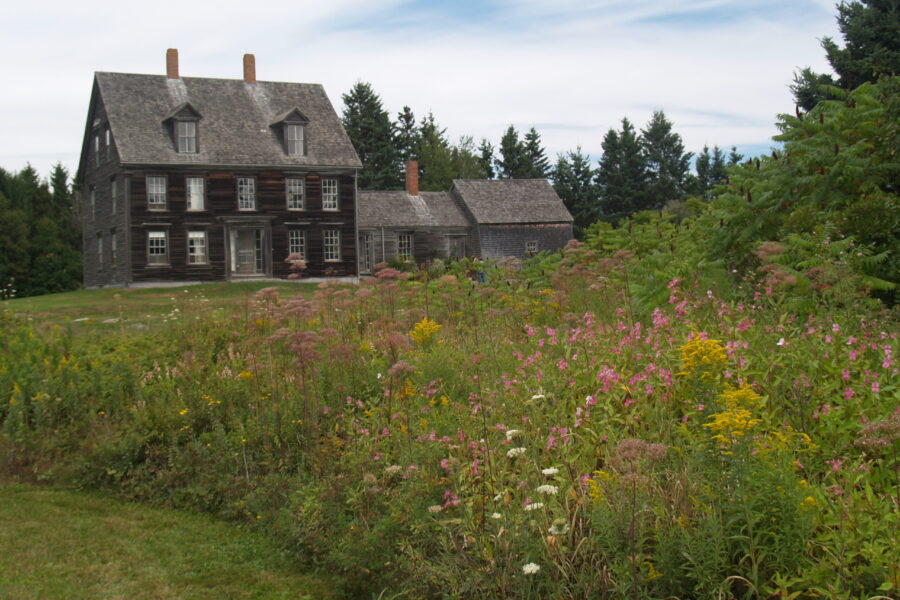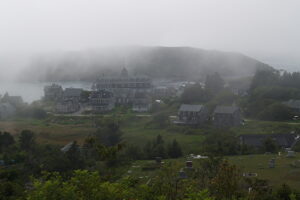The Olson House
Noon finds us winding our way to the Olson House in Cushing, Maine, traveling down narrow lanes that lead to narrower paths. Rounding a corner protected by a row of trees, at the bare edge of the road we are greeted by the overwhelming presence of the rear view of three stories of dark, weathered wood.
“This has to be it,” I say.
For what else could it be?
We drive around to the side of the property and park our convertible, top down. Three women are sitting at a tree-shaded picnic table having wine and chips. I smile and tell them I wish that I had thought of a picnic. One woman calls back that she can’t hear very well, but she understands my sentiment. She smiles back.
The next tour of the Olson House does not begin till 1 p.m., so we wander at will. Michael takes his camera and goes outside. I start in the living room and then begin the climb to the third floor, stopping at a myriad of decayed and decaying rooms along the way. I itch to paint what I see. Tone on tone of white and beige, peeling paint, weathered walls. A lone chair. A window with a view of the sea.
Andrew Wyeth
I have always loved the subdued earth tones of Wyeth’s paintings. The naked rawness, believing these were images conceived by his artistic genius. However, now I realize it was his creative way of seeing things, his re-imagining them, and the meticulous detail in his renderings, that seems to me to be the genesis and genius of his work. He painted what he saw, and here, right here, what he saw was the somber and aged domain of siblings Christina and Alvaro Olson. A small world at the edge of one of Maine’s myriad finger peninsulas. A world filled with physical pain and patience and perseverance, hard work and quiet joy.




There are prints of Wyeth’s paintings in some of the rooms, inspired by the scenes before me. I see his paintings and am awed by his patience and painstacking execution. I learn all he wanted to do was paint—and he did, eight hours a day, seven days a week.


Learning the History
At one o’clock a beautiful young man leads us into a room where we are seated on hard wooden benches listening to his deep rich voice as he transports us back in time to the years of the mid-1700s when a house was first built on this land. We learn about rusticators—there have always been summer people in Maine! The passion for painting that drove Wyeth. His love of the Olson House and the pictures he painted during his summers here.
He weaves a tale beginning with the witch trials in Salem and ending with Christina Olson’s first glimpse of Wyeth as she looked out a window and watched as he stood at his French easel, painting the home in which she had lived her life. In the future, he will maintain a studio here and return for thirty summers during the years 1939 to 1968.
Learning that the house looks better now than it did when Christina and her brother, Alvaro, lived here during the last years of their lives, I read a quote from Andrew Wyeth.
“I just couldn’t stay away from there. I did other pictures while I knew them but I’d always seem to gravitate back to the house.”



An hour later we are seated once again as we listen to the nephew of Andrew Wyeth talking about his family and uncle—“He worked hard and he played hard.”
Family pictures are passed around the circle of Wyeth admirers; we view brochures from his first shows. I handle them with care, touching only the edges, thinking they are priceless, and one day should reside in a museum—I am the only one that does this.
Three hours later we emerge from Christina’s World and begin the journey home.
A Promise
Arriving at our summer cottage, I gather my things, clutching them to my chest as I walk up the flagstone path to the porch. When I reach the front door I look down. There, standing in silent accusation is my French easel. Folded up tight. Locked. The easel that has traveled with us from the hills of Texas to Niagara Falls, to Montreal, to Monhegan, and here—to our Cottage by the Sea. Waiting.
Where is your drive, it asks? Where is your passion?
Maybe tomorrow, I promise. My passions are many. My days lack the hours to follow them all. Maybe tomorrow, I promise.
Christina’s World

The first time I saw a copy of this Wyeth painting, I didn’t know the title. I didn’t know the story. Every painting speaks to each person in a different voice, whispers a different story. What I saw that day was a story of quiet desperation. Abandonment. Hopelessness. Someone who was alone and struggling, trying to reach an impossible goal. Being here, now knowing the real story, my interpretation—although purely from an emotional female perspective—was not far from wrong. Alone and struggling, trying to reach an impossible goal, but not hopeless. Not desperate. This artistic rendering was a portrayal of a woman’s fierce determination and struggle against dependence.
The woman in the picture, Christina Olson, suffered from a debilitating muscular disorder, refusing the use of a wheelchair till the last few years of her life. She lived most of her existence as an invalid, dragging herself everywhere she went. Wyeth, looking out the window of his studio at the Olson house one day, saw Christina clawing her way up the hill to her home after visiting her parent’s gravesite. Painted in 1948, Christina Olson was in her 50’s. Wyeth was 31. Although Christina inspired the painting, experts say that Wyeth used his young wife, Betsy, as the model for the torso.
8/23/2014 3:17:32 PM









Leave a Reply
Your email is safe with us.